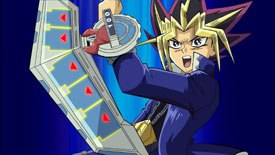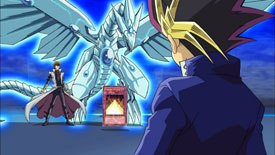Anime expert Fred Patten chronicles the phenomenon that is Yu-Gi-Oh!

Yu-Gi-Oh! is the newest Pokémon, but will the feature do as well in the theaters as its other anime processor. All images courtesy of Warner Bros. Pictures. © Kazuki Takahashi.
Ask any of Yu-Gi-Oh!'s screaming preadolescent fans what the difference is between Yu-Gi-Oh!: The Movie and the earlier theatrical movies of Pokémon and Digimon -- also Japanese theatrical features of megapopular TV cartoon series based upon equally popular Japanese games and comic books -- and they will probably look at you blankly. Many of them may be too young to remember Pokémon and Digimon, whose popularity peaked a whole two or three years ago.
Ask the general public what the difference is, and they will be equally mystified. They are all just theatrical movies of popular TV cartoons imported from Japan, aren't they? Parents of young anime fans may be aware of other Japanese animated features of popular TV cartoons that were theatrical releases in Japan but only direct-to-video releases in America: Dragon Ball Z, Sailor Moon and Cardcaptors.
To the animation industry insider, the difference is that Yu-Gi-Oh!: The Movie is the first feature-length spinoff of a mega-popular children's game/TV series that was produced in Japan for an American theatrical premiere and release. Warner Bros. is releasing it domestically on Aug. 13, 2004. No theatrical release has been announced for Japan, at least through the end of October.
Practically all previous Japanese theatrical features have been made primarily for the Japanese domestic market. Any sales to America or other international markets have been a pleasant bonus. Technically Digimon: The Movie was also an American original, but it was basically three Japanese 1999 and 2000 Digimon theatrical featurettes edited together. Little or no additional original animation was required. The anime fan/video market in America has grown to the extent that it is now considered in Japan as a serious factor in planning new projects.
The best example of this is Vampire Hunter D: Bloodlust, which was promoted with trailers at American anime fan conventions for two years before the movie's September 2001 release. But it never achieved more than a limited art-house theatrical release in America, and did not do much better in Japan. Its major revenues, as had been expected all along, came from the home-video sales and the ancillary movie-fan merchandise such as the D: Bloodlust T-shirts, music CDs, posters and similar memorabilia.

Yu-Gi-Oh! has more than just these monsters to deal with at the box office, opening on the same day as Alien vs. Predator.
Even the super-prestigious Spirited Away by Hayao Miyazaki was a theatrical failure in America despite rave reviews and being released in over 700 theaters by Disney. The only Japanese animated theatrical features to have been successful as American theatrical releases have been those spinoffs of mega-popular children's TV cartoon series that were released at the height of their TV popularity in America. Of the top four U.S. anime theatrical grosses in their first-runs, the ranking is:
1. Pokémon The First Movie: Mewtwo Strikes Back Nov. 12, 1999 -- $85,744,6622. Pokémon The Movie: 2000 -- July 21, 2000 -- $43,758,6843. Final Fantasy: The Spirits Within -- July 11, 2001 -- $32,131,8304. Pokémon 3 -- April 6, 2001 -- $17,052,128
Digimon: The Movie (Oct. 6, 2000) grossed $9,631,153. Spirited Away did better than that, but not as well as Pokémon 3.
Warner Bros. and 4Kids Entertainment, the American distributor and producer of Yu-Gi-Oh! (and by no coincidence also the distributors and producers of Pokémon) would like a chance to equal the $40+ million grosses of the first two Pokémon movies. Right now Yu-Gi-Oh! is mega-popular in America -- maybe as popular as it will ever be. The TV cartoons have been on Kids' WB! since September 2001, and are still high in the ratings.
Konami Digital Entertainment and Upper Deck Entertainment, creators of the Yu-Gi-Oh! videogames and collectible trading card games respectively, have just held the Yu-Gi-Oh! gaming U.S. finals at the Comic-Con International in San Diego on July 22-23, and the Yu-Gi-Oh! World Championship Tournament at the Anaheim Convention Center on July 25. (Press release: "In front of a crowd of more than 10,000 fans, 12 finalists from eight countries (USA, Japan, France, Germany, U.K., Italy, Holland and Spain) will compete for the highly coveted Yu-Gi-Oh! trophy and the honor of being the Yu-Gi-Oh! World Video Game Champion.")
VIZ, the American publisher of the Yu-Gi-Oh! manga graphic novels which have been appearing every three months, has announced that it will increase its publication schedule to monthly in February 2005 due to reader demand.

Unlike Pokémon, the Yu-Gi-Oh! theatrical feature was not made for Japan initially.
Clearly, now is the time to take theatrical advantage of Yu-Gi-Oh!'s popularity. Since no Yu-Gi-Oh! theatrical exists in Japan for WB and 4Kids to license, they have arranged for the creation of one with the Japanese producers of the Yu-Gi-Oh! TV animated series, Studio Gallop in Tokyo (directed by Hatsuki Tsuji) and Gallop's subcontractor in Seoul, Dong Woo Animation Co. Ltd.
Yu-Gi-Oh! (translation: King of Games), created by cartoonist Kazuki Takahashi, began in Japan's Weekly Shonen Jump manga magazine in 1996 and is still running. It first appeared in animation as a 27-episode TV series from April 4 through Oct.10, 1998, produced by Toei Animation Co. The current TV series by Studio Gallop, titled Yu-Gi-Oh!: Duel Monsters in Japan, began on April 18, 2000 and is still running; episode #216 was broadcast on August 4.
The premise is that, 5,000 years ago at the dawn of civilization, supernaturally powerful Egyptian wizards held mystic battles called Shadow Games for world supremacy. These sorcerers battles escalated until they threatened to destroy the world. Finally the most powerful of the good wizards, the Pharaoh, defeated his enemy, Anubis, and sealed away the magic "for eternity" for the safety of the world. It was supposedly the dim memory of these events that led the Egyptians to call their future monarchs the Pharaohs, and name their Lord of the Dead, Anubis.
But "not even eternity lasts forever". Jump forward to the present. Duel Monsters, a new trading card-battling game, has just become the hottest fad with the world's youth. Players compete with cards of monsters and magic such as Summoned Skull, Blackland Fire Dragon and Mystic Lamp to win each other's "life points." Unknown to anyone, Duel Monsters is a reincarnation of the Shadow Games, and their ancient supernatural master-players are also about to be reborn.
Yugi Moto is a frail-looking boy whose grandfather owns the most popular gaming shop in the city. He has in his personal collection a rare ancient Egyptian game, the pyramid-shaped Millennium Puzzle. Nobody has been able to solve it until he gives it to Yugi, who becomes obsessed with it. His obsession for years gets him as reputation with his classmates as a nerd, until he finally solves it in high school. This releases the soul of the Pharaoh, Yugi's psychic double, which resides in the Puzzle.
Actually, that was not revealed until about two years into the series. For the first comic book stories and the original 27-episode TV series, Yugi's mystic alter ego was named Yami Yugi; Dark Yugi. Yu-Gi-Oh! was a schoolboy's revenge fantasy. Yugi's high school and neighborhood was populated with sadistic bullies. Yugi had the courage but not the strength to stand up to them. Dark Yugi would take over Yugi's body and challenge each bully to a game that required skill and nerve rather than strength. When the bully lost, a supernatural revenge would befall him.

The success of Yu-Gi-Oh! was injecting the card game craze of Magic and Pokémon into the show itself.
Around 1999 the fictional Duel Monsters card game, which had been developed into a merchandising spinoff, became unexpectedly popular. The card game and a series of video games were expanded, and the comic book and TV animation story line quickly shifted emphasis to concentrate on these. Several regular villains were introduced; notably Maximillion Pegasus, the reincarnation of the ancient wizard who created the Shadow Games, and Seto Kaiba, a spoiled teenage millionaire who is the heir of the world's largest toy and gaming company. He arrogantly believes that he is also destined to be the world's gaming champion, and he does not hesitate to cheat to defeat Yugi at Duel Monsters. Since the cards have now regained their ancient supernatural powers, Yugi must prevent their misuse, which can endanger the world.
It is in the long "Battle City" story-arc in the TV cartoons, running from episodes #50 through #144, that Dark Yugi is identified as the ancient Pharaoh. There are shifting alliances between teams of players. By the end of this series, Yugi has defeated Kaiba once again and won the three all-powerful Egyptian God Cards, which are the treasure of that plot.
Yu-Gi-Oh!: The Movie (with a further subtitle-card: The Pyramid of Light, and a tagline: "Everything Else Was Just Practice") is set right after episode #144, though it is written so that viewers unfamiliar with the TV cartoons can quickly pick up the necessary background. Kaiba, seething over his latest defeat, seeks out Pegasus and forces him to surrender a card so powerful that Pegasus was afraid to use it. This Pyramid of Light card was the one with which Anubis almost defeated the Pharaoh in the past. Kaiba does not realize that he is being manipulated by the spirit of mad Anubis who intends to destroy the whole world as soon as Kaiba has won.
All the past Duel Masters cards, which were featured in the TV episodes (notably Yugi's favorite Dark Magician Girl, Kaiba's Dark Clown, and the three Egyptian God Cards), are reintroduced and soon trumped, as the Pharoah's soul in Yugi's body fights in this all-important Tournament to save the world once again.
The movie has a second tagline: "Can This Be The Final Duel?" Not likely, since every Yu-Gi-Oh! fan knows that the TV series has already continued the story past this point. But there is still plenty of big-screen action to please the preadolescent fans, several hundreds of whom descended upon Grauman's Chinese Theater in Hollywood on August 7 for a premiere a week before the movie's release.
WB and 4Kids hosted a one-hour "Organized Yu-Gi-Oh! Card Game-Play and Magician's Workshop" in the theater's adjacent parking lot, where the kids got to win T-shirts, DVDs of the TV cartoons, Duel Monsters collectible cards and other goodies before going in to watch the movie. Judging by the decibels of their screaming, they loved it! Now to see if the nation's kids will reflect this enthusiasm at the box-office.
Fred Patten has written on anime for fan and professional magazines since the late 1970s. He wrote the liner notes for Rhino Entertainments The Best of Anime music CD (1998), and was a contributor to The World Encyclopedia of Cartoons, 2nd Edition, ed. by Maurice Horn (1999) and Animation in Asia and the Pacific, ed. by John A. Lent (2001).







